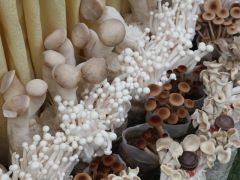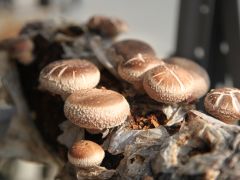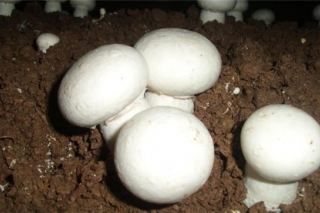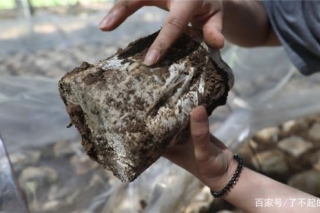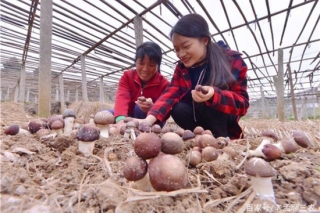TI: Effect of inoculation with Volvariella volvacea on nitrogen status of alkali treated rice husk.
AU: Suri-VK; Datta-B
SO: Research-and-Development-Reporter. 1994, 11: 1-2, 38-42; 9 ref.
LA: English
PT: Journal-article
AN: 960711567
TI: Mineral content of edible (dehydrated) mushrooms.
AU: Verma,-A; Keshervani,-GP; Sharma,-YK; Sawarkar,-NJ; Pratibha-Singh
SO: Indian-Journal-of-Nutrition-and-Dietetics. 1987, 24: 8, 241-245; 5 ref.
LA: English
AB: Contents of phosphorus, sulphur, calcium, magnesium, sodium, potassium, iron, copper, zinc and manganese in different parts of the edible mushrooms Agaricus bisporus, Pleurotus sajor-caju and Volvariella volvacea are tabulated.
PT: Numbered-Part
AN: N072212
TI: Relation between microbial communities in different layers of substrate and fruiting body yield of Volvariella volvacea.
AU: Yang,-GL; Zheng,-SL; Li,-XJ; Li,-YJ
SO: Zhongguo-Shiyongjun-=-Edible-Fungi-of-China. 1990, No. 4, 19-20.
LA: Chinese
AB: The outer, middle and inner layers of a composted substrate composed of 82% rice straw, 15% sheep manure, 2% wheat husks and 1% Ca + Mg + P were inoculated with V. volvacea. The microbial populations of the different layers and their relationship with fruiting body yield were studied. Bacterial and mycobacterial populations decreased in the following order: outer layer (4.8 X 109 + 7.8 X 105) > middle layer (7.7 X 108 + 1.9 X 105) > inner layer (4 X 108 + 4.3 X 104). The populations of other microbes were greater in composted than in fresh substrate. Mycobacteria and most other bacteria had inhibitory effects on the growth of spawn, but N-fixing bacteria promoted growth. Organic C, crude fibre contents and the C/N ratio were lower but N and K contents were higher in the inner layer than those in the outer and middle layers. Temperature varied with the layers. The inner layer had the highest mean temperature (66C). The fruiting body yields from the inner, middle and outer layers were 23.1, 16.2 and 10.2 kg/100 kg, respectively.
PT: Numbered-Part
AN: C068897
TI: The yield-increasing effect of Fu-Gu-Tai on edible fungi.
AU: Liu,-HZ; Chen,-W; Liu,-QY
SO: Zhongguo-Shiyongjun-=-Edible-Fungi-of-China. 1990, 9: 4, 21-22.
LA: Chinese
AB: Lentinula edodes, Volvariella volvacea and Agaricus bisporus were sprayed with 0-16 g/ml Fu-Gu-Tai, a substance extracted and purified from Streptococcus. The yields of L. edodes with 6-8 g/ml Fu-Gu-Tai, V. volvacea with 10 g/ml, and A. bisporus with 8-16 g/ml were increased by 23-59%, 68.1-127.8% and 20.9-263.6%, respectively. Fu-Gu-Tai had a strong inhibitory effect on the activity of acid proteinase and increased the activity of neutral proteinase. Fruiting body quality was not affected.
PT: Numbered-Part
AN: C068900
TI: Nutritional influences on Volvariella volvacea (Bull. ex. Fr.) Sing. growth in Puerto Rico. I. Carbon and nitrogen.
AU: Torres-Lopez,-RI; Hepperly,-PR
SO: Journal-of-Agriculture-of-the-University-of-Puerto-Rico. 1988, 72: 1, 19-29; 19 ref., 4 col. pl.
LA: English
LS: Spanish
AB: Laboratory tests were conducted to determine the growth of a Puerto Rican strain of straw mushroom Volvariella volvacea on diverse C and N sources at variable C:N ratios. Of four C sources, corn starch and cellulose supported the most vigorous growth. No growth was observed on lactose or maltose. Urea, sodium nitrate, peptone and casein were tested as N sources at C:N ratios of ?1, 60:1, 30:1 and 15:1 with corn starch as the sole C source. The 60:1 C:N ratio supported the best growth. Urea and sodium nitrate did not support growth but casein and peptone stimulated growth with the faster growth occurring on casein.
GE: Puerto-Rico
PT: Numbered-Part
AN: C961907
TI: Influence of the composition of the substrate and its heat treatment on the growth of the mycelium and the yield of Volvariella volvacea.
OT: Der Einfluss der Zusammensetzung der Substrate und ihrer thermischen Behandlung auf das Wachstum des Myzels und den Ertrag von Volvariella volvacea (Bull. ex Fr.) Sing.
AU: Jablonsky-I
SO: Champignon. 1981, No. 241, 26 . . . 34; 3 pl.; 5 ref.
LA: German
AB: Substrates consisting of standard mushroom compost (prepared with 11 days at stage 1 and 8 days at stage 2), horse manure (composted for 3 days) and wheat straw treated in various ways were compared. Half of each substrate was treated for 4 h at 90 deg C (pasteurized) and the other half at 120 deg (sterilized) for 1.5 h. Mycelial growth was best in the mushroom compost and growth was generally better in the pasteurized than in the sterilized substrate. No fruiting bodies were formed with the horse manure substrate. The highest yields were with chopped wheat straw. The addition of 3% CaCO3 reduced yields and in all cases pasteurization produced higher yields than sterilization.
PT: Journal-article
AN: 810303608
TI: The use of various ligno-cellulose substrates for the culture of Volvariella volvacea, the paddy straw mushroom.
OT: L'utilisation de substrats ligno-cellulosiques divers pour la culture de Volvariella volvacea, le champignon de la paille de riz.
AU: Sun,-S; Delmas,-J
SO: Comptes-Rendus-des-Seances-de-l'Academie-d'Agriculture-de-France. 1985, 71: 2, 193-199; 5 ref.
LA: French
AB: In a first trial with 3 media (composition given) many fruiting body primordia were formed after 15 days on medium B (in which cellulose replaced glucose) but not on medium A (glucose) or C (no glucose). In another trial with several organic wastes the most primordia were obtained on oil geranium waste (from Reunion) and maize leaves and stems. In a 3rd trial fruiting was earlier and more intense on carded cotton substrate than on wheat straw. The results are discussed in relation to incubation temperature, usually 30C or above.
GE: France-
PT: Numbered-Part
AN: C305660
TI: Cultivation and chemical composition of the paddy-straw mushroom (Volvariella volvacea).
AU: Zakhary,-JW; El-Mahdy,-AR; Abo-Bakr,-TM; El-Tabey-Shehata,-AM
SO: Food-Chemistry. 1984, 13: 4, 265-276; 32 ref.
LA: English
AB: Four spawn media for growing paddy-straw mushrooms were tested. The presence or absence of urea and the use of barley or sorghum had no effect on mycelial growth. The addition of yeast extract to the barley grain medium gave heavy growth of mycelium compared with other media. Seven different media were prepared for the cultivation of mushrooms using local materials such as orange juice waste (OJW), rice straw (RS), bagasse (B), pea-canning waste, horse manure (HM) and molasses. Media containing OJW, B, RS, HM, molasses and urea gave the highest yields of mushroom. Mushrooms harvested from OJW-B medium contained in DM, total nitrogen 4.9, non-protein N 1.6, ether extract 2.7, crude fibre 17.4, reducing sugars 6.1, non-reducing sugars 4.2, starch 19.2, glycogen 5.2, mannitol 9.9 and ash 12.6%. Of 14 amino acids present, 7 are essential, and methionine, arginine, histidine and serine are absent. Tryptophan concentration (14.7% in protein) was higher than in any other wild mushroom or legume seed.
PT: Numbered-Part
AN: N608988
TI: Performance of exotic and local strains of Chinese mushroom Volvariella volvacea (Bull. ex. Fr.) on different substrates.
AU: Iqbal-SM; Muhammad-Banaras; Banaras-M
SO: Pakistan-Journal-of-Scientific-and-Industrial-Research. 1993, 36: 6-7, 276-277; 5 ref.
LA: English
AB: Spawn of a local and exotic (V559) strain were inoculated onto rice paddy straw and blow gutter cotton waste, and mushrooms were harvested during the cropping period of 2.5 months. The highest yield of 2319 g was obtained from the local strain grown on the paddy straw substrate.
GE: Pakistan-
PT: Journal-article
AN: 941603890
TI: Nutritional value in respect of sugar, starch and ascorbic acid content of two mushroom mycelia grown on agroindustrial wastes.
AU: Kundu-RB; Nandi-B
SO: Journal-of-Mycopathological-Research. 1994, 32: 1, 51-57; 16 ref.
LA: English
AB: The edible fungi Volvariella volvacea and particularly Pleurotus ostreatus were efficient at converting agroindustrial wastes (2% rice straw dust or sawdust) into valuable carbohydrate (sugar and starch) and ascorbic acid when grown in a basal medium containing 0.2% each of phosphoric acid and ammonium sulphate and 0.02% magnesium sulfate. The carbohydrate and vitamin C content of the mycelia peaked after 30 days' incubation.
PT: Journal-article
AN: 950307833
TI: Nutritional value in respect of sugar, starch and ascorbic acid content of two mushroom mycelia grown on agroindustrial wastes.
AU: Kundu-RB; Nandi-B
SO: Journal-of-Mycopathological-Research. 1994, 32: 1, 51-57; 16 ref.
LA: English
AB: The edible fungi Volvariella volvacea and particularly Pleurotus ostreatus were efficient at converting agroindustrial wastes (2% rice straw dust or sawdust) into valuable carbohydrate (sugar and starch) and ascorbic acid when grown in a basal medium containing 0.2% each of phosphoric acid and ammonium sulphate and 0.02% magnesium sulfate. The carbohydrate and vitamin C content of the mycelia peaked after 30 days' incubation.
PT: Journal-article
AN: 950307833
TI: Basidiocarp prodution in Volvariella volvacea in laboratory cultures.
AU: Santiago,-CM, Jr.
SO: Kalikasan,-Philippine-Journal-of-Biology. 1983, 12: 1/2, 70-76; 18 ref., 1 pl.
LA: English
AB: Various substrates, substrate temperatures and cultural methods were investigated. Wheat straw supported good mycelial growth and fruiting; newspaper alone was unsatisfactory, but growth and fruiting improved with the addition of wheat straw at increasing levels of 25-95%. Flask cultures (using sterilized wheat straw) yielded fewer pinheads and mature fruiting bodies than did wire-basket cultures (unsterilized straw), and fruiting was delayed unless humid air was circulated through the flask. Optimum temperature and RH requirements differed with the phase of basidiocarp development.
PT: Numbered-Part
AN: C196119






